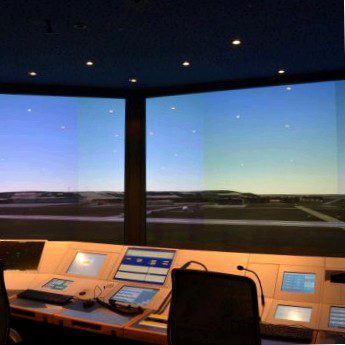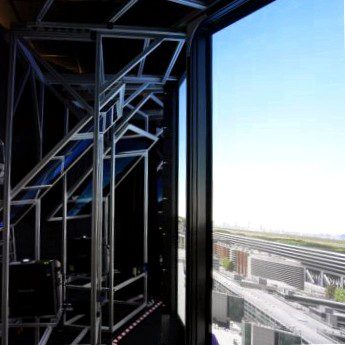A similar tower simulator can be found worldwide only in Israel so far. This was also realized by Viscon in cooperation with the American software partner UFA – for the Israel Airports Authority. For the current project, Deutsche Flugsicherung was the client.
Air traffic control training was handed over to DFS by the German Armed Forces. DFS subsidiary KAT (Kaufbeuren ATM Training) is now responsible for training. For this purpose, a modernized training center was created at the Kaufbeuren air base.
Technical details of the tower simulator
The centerpiece of the simulator center is the new 360-degree tower simulator, which was also the highlight at the official handover in February 2017. The details:
- Customized rear projection system
- Content is projected onto acrylic glass panes via deflection mirrors.
- The projection screens are positioned around the simulated workstations
- 16 phosphor laser beamers work behind the acrylic glass panels.
- Full-HD with a resolution of over 36 million pixels
- extremely high-contrast, sharp display for realistic simulation of even difficult viewing conditions (e.g. night exercises or hazy weather conditions)
With the previous system, twice the number of projectors only managed a much lower resolution. By converting the previously analog technology to digital technology, u. a. the hardware in the rack room to be reduced to 10 % of the old system.
 Towersimulator // 360° // German Air Traffic Control
Towersimulator // 360° // German Air Traffic Control 
High demands also on the simulation software
In contrast to the German Armed Forces, instructors and students go through the exercise sequences again in the debriefing room afterwards. Here, instructors can now also intervene in exercises and simulate the effects of changed instructions. The software adaptation on the part of Viscon partner UFA was correspondingly complex. In addition, the simulator software at the two DFS sites in Kaufbeuren and Langen should be identical. As a result, the new "what-if" function can now be used here as well as there, and the system as a whole can be kept at a uniform level.
On-time realization in a short time
In January, those responsible met for an initial workshop. After four further meetings with training managers, teachers, technicians and representatives of the Bundeswehr, a list of requirements was defined at the end of April and UFA was commissioned to expand the simulation software. A short period of five months was allotted for the software adaptations. Normally, such extensive software adaptations take three years to complete.
In November, the project team was able to start dismantling the old systems and building the new simulator. The build-up was already completed by the end of the year. Again: an extremely narrow time window.